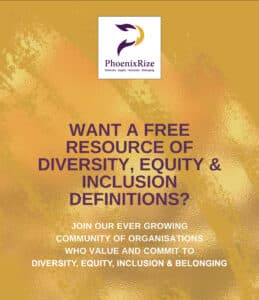Starting your DEI journey? Here are 5 Steps
DEI stands for Diversity, Equity, and Inclusion, but it is a lot more than the sum of these terms. DEI refers to the field that focuses on creating and sustaining a diverse workforce, an inclusive environment, practice, and policies as well as making sure everyone is treated equally and according to the systemic barriers they face. In an organisational context, DEI is an encompassing practice and lifestyle: it is embedded in everything the organisation does, from recruitment to policies to the inclusive leadership and having inclusive teams. It is about making a change and sustaining that change in a constantly developing organisational and social landscape.
Many of us want to do better but have no idea where to start from. Looking at the scale of organisational changes that DEI is capable of achieving, they can look grand and overwhelming. The aim is that with processes that, when successful, are embedded into the entirety of the organisational structure, we might not know where to start – or where to even start looking. This blog post will give you a framework that you can use when starting your DEI journey: consider this an overview of the most important steps when starting with or wanting to start your journey with DEI.
Step 1: Find your why
Since you are reading a DEI blog, you are probably already aware of your why, but it is important to elaborate this for future purposes. Everything you do from this moment onwards is rooted in the “why”, so try to expand and hone your reasoning behind the initiative. There might be multiple or intersecting cases, such as a legal requirement and concerns about inclusion, cases of harassment, racism or sexism, a will to increase your brand value, a need to build your diversity to reflect the customers you serve and so on. When you are sure why you are doing this, you will have an easier time explaining and motivating your initiatives and opinions to other stakeholders.
Step 2: Map it out
I see people ignore and dismiss this step way too often, but simply, you need to know where you are to know where you are going. It is great that you are willing to commit to DEI in your organisation, but just blindly starting any kind of process will end in failure. It is not enough to start recruiting for diversity in general, you need to know what your organisation looks like now: who works for you and what kind of representation do you need or want to increase.=
Start with mapping out your current situation. Depending on your organisation and its current state and situation, you will need as much data as possible from your current situation. Often you can start with the data you already have, such as recruitment statistics, employee demographic data and logs of promotions. If you don’t have this basic data yet, start with it. This kind of statistical data will tell you how diverse your company is: who is represented and who is not. It will also help you define how equity looks like in your organisation: where do you have discrepancies with factors such as equal pay or chances for promotions.
When you have your diversity and equity mapped out, you can move on to inclusion. Measuring inclusion is a more challenging task: you will need to do opinion surveys and interviews or other forms of feedback to find out how your employees feel like working for you.
When you have figured out your current situation, you can see where change needs to take place.
Step 3: Write down your goals & create a case
Diversity, Equity and Inclusion initiatives will not create change overnight nor are they one-off projects. They require a long-term, organisation-wide commitment, and thereby also long-term goals and commitment to these goals. The goals need to have clear intervals (such as 1, 3 and 5 year goals) and most importantly you need to be able to measure them somehow. Goals that are not measurable, such as “become a healthy working place for diverse people” are also needed, but are hard to implement to other organisational processes, or to keep track of.
When you have got your goal figured out, you can start to create a case for the initiative. Before you communicate a DEI initiative or idea to your stakeholders, you need to have a “why are we doing this and why now” as this is crucial for stakeholder commitment, especially for leadership. Not only is it important to communicate why you are doing it, but what will happen if these changes don’t take place immediately. Besides this, remember to include a “what’s in it for me” factor: the stakeholders need to know what they gain from it, rather than focusing on what will change and what others will gain.
Step 4: Build a strategic plan
Before you write out a delivery plan, consider: what are the key themes in our data, but also in our vision for the goals? While there might be multiple themes, not all of them need to be included in your initial plan: focus on creating overarching structures that support each other. That way it is easier to take action when the time comes: a scattered plan will be harder to follow through. Consider carefully which areas of the organisational processes need to be included, as well as whether you want your clients or suppliers to be included in your DEI efforts as well.
What kind of timescale is appropriate for the plan? Who will be in charge? Line out the details, and make sure to include the entirety of the workforce and leadership to the plan on some level.
While we encourage making long-term plans and commitments, make sure to line out some short-term wins: seeing progress is the best motivator.
Step 5: Work with external providers
You are not alone with the massive change that is about to take place. Whether it is with analysing data, conducting surveys, revising policies or designing plans and training, there are external providers who can support and complement your competencies during your journey. Not only do they offer another perspective to the change about to take place, they are experts in dealing with diverse people, cultures and challenges. External providers might be in a better position to challenge the company culture and call out mistakes, misconducts and biased structured and behaviour than what someone inside the organisation is.
PhoenixRize has experienced it all: we have helped small organisations to get started and established ones to take their DEI to the next level. We have competencies in consulting all areas of DEI, no matter what you need support with. To get more guidance on starting your DEI journey, or troubleshoot a current one, get in touch (insert email address)
Now we have covered the theory as to why and how you focus and implement your DEI work, it is over to you. We round off this blog with a call to action for you and your organisation to ensure you get off to the right start for all things DEI.
- Find your why – speak to your organisation, look at your data, discover why you want and need to focus on DEI specifically related to your organisation.
- Establish where you are at – Be candid in deciding where your organisation is currently at. For our member, check out the Meyer Spectrum Tool or the Deloitte Matrix in our members area to guide you in this step.
- Start to build your plan – start small and build upon your foundation. What are the keys areas you must focus on initially and then think longer term? If you’re looking to build out a DEI strategy and you’re a member on our website, check out our Step-by-Step guide to creating a DEI Strategy that works!
- Be Transparent – this may be the 4th action step, but it is arguably the most important. DEI is built upon trust, so ensuring your are transparent in the good and bad is key to driving a diverse, equitable and inclusive environment.
Visit our website for more great content: https://www.phoenixrize.ie/


